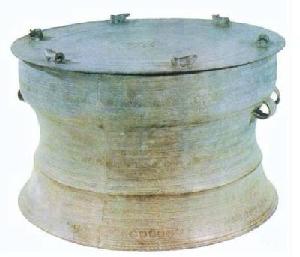Inspired by the shape of drum or bronze basin, bronze drums are percussion instrument of the ethnic groups in the southwest of China. Applied to sacrifice rites, the bronze drums were usually used to play music or accompany with dance. Popular in Yunnan, Guangxi, Guangdong, Sichuan and Hunan provinces in the south of China and spread to East Asian countries, the bronze drums were initiated in the Autumn and Spring Period (770-476BC). The bronze drums of the Han Dynasty (206BC-220AD) are among the most excellent ones.
 |
|
Bronze drums were molded by clay or stone and cast by bronze alloy. The upper part is the drum face and the lower part is the drum body, which is hollow. One bronze drum is composed by five parts, namely the face, chest, waist foot and ear. The face of the drum is smooth with the center a little bulged, decorated with lines of the sun rays, and images of the toads, tortures, birds and knights were carved on the outer part of the rays. The drum chest is connected with the drum face in an arc form. The waist of the drum is like a tube, with the drum feet below it, which are smaller in the upper part and bigger in the lower part like a cone. Bronze drums later featured no obvious borderlines between the waist and the foot, and some even had no feet. There is always a pair of drum ears between the chest and waist symmetrically, with lines carved on as decoration.
In terms of region and design, bronze drums fall into two styles: Dian and Yue. Bronze drums of the Dian Style were popular in Yuannan, Guizhou, Sichuan and Hunan Provinces, among which, the central Yunnan Province and the west of Guangxi Province have the largest number. Bronze drums of the Dian Style are small in size; the diameter of the face is within one meter, which is smaller than the diameter of the body. Bronze drums of the Yue Style were popularized in the southeast of Guangxi Province and the southwest of Guangdong Province. Bronze drums of the Yue Style are large in size and finely cast, whose face is larger than the chest, as well as the waist.
